Title search results
Showing 1 - 20 of 20 items

Our planet! there's no place like earth
By Stacy McAnulty. 2022
Our Planet! There's No Place Like Earth is a nonfiction audiobook about the Earth, told from the perspective of Earth…
herself. Meet Earth. Planet Awesome! And your awesome home! Actually, Earth is home to all the plants and all the animals in the solar system, including nearly eight billion people. Humans have accidentally moved Earth's climate change into the fast lane, and she need your help to put on the brakes. Earthlings need Earth, and Earth needs Earthlings, so let's save Earth together! With characteristic humor and charm, Stacy McAnulty channels the voice of Earth in this next celestial "autobiography" in the Our Universe series. Rich with kid-friendly facts, this is an equally charming and irresistible audiobook. A Macmillan Audio production from Henry Holt and Company
A hundred billion trillion stars
By Isabel Greenberg, Seth Fishman. 2017

Hey there, Earth dweller!: dive into this world we call Earth
By Laura Watkinson, Marc Ter Horst, Wendy Panders. 2019
A quick overview about how our planet was formed, its composition, and how it continues to evolve. Includes discussion on…
climate change and Earth dwellers. Translated from the 2014 Dutch edition. For grades 4-7. 2014
Astronaut, aquanaut: How Space Science and Sea Science Interact (Nat Geo - Science And Nature Ser.)
By Jennifer Swanson, National Geographic Kids, Parry Gripp. 2018
Highlights the differences and similarities between the deep ocean and outer space. Discusses the danger--and attraction--of exploring both of these…
vast domains, the technology involved, and amazing discoveries. For grades 4-7. 2018
Space on Earth: How Thinking Like an Astronaut Can Help Save the Planet
By Dave Williams. 2023
Really “high” tech to inspire us for sustainable solutions on Earth.Who could imagine an idea born on a space station…
would help sustain our planet? Astronauts, living on the International Space Station, have to protect their resources because their lives depend on it. They learn to conserve water, air, food, energy, and waste.These efforts have in turn lead to amazing and innovative ideas for air quality, food production, and water purification here on Earth.With vivid, energetic illustrations, photographs, and Dr. Dave’s experiments on key topics, readers learn about technological innovations such as waterless toilets and the world’s tallest air purification tower.
Searching Beyond the Stars: Seven Women in Science Take On Space's Biggest Questions
By Nicole Mortillaro. 2022
Are we alone in the cosmos? Could we one day live on a different planet? How is life formed? What…
other secrets does the universe hold? Through profiles of seven remarkable women scientists and their achievements in their respective fields, Searching Beyond the Stars takes us deep into space, looking at once to the distant past and the distant future to capture the awe and intrigue of some of the biggest questions we can possibly ask.Making connections across astronomy, chemistry, physics, history, and more, Nicole Mortillaro draws on her own experience as a woman in STEM to highlight the incredible odds each scientist faces while chasing new discoveries and the ways in which sexism and racism, among other barriers, still affect women scientists to this day. Sidebars filled with fascinating facts take readers behind the science and encourage them to delve deeper. Vibrant illustrations by Amanda Key showcase the wonder of space and the passion and eternal curiosity that drive each scientist in their work unfurling the mysteries of our universe.Scientists ProfiledKatherine Johnson, research mathematician and aerospace technologist at NASA. Helped get the first American astronauts into space and safely home again. Lived in Newport News, Virgina.Jill Tarter, radio astronomer and project scientist at NASA. Opened up possibilities for communicating with aliens. Lives in Berkeley, California.Sara Seager, astrophysicist and planetary scientist. Credited with laying the foundation for the field of exoplanet atmospheres and the search for life on exoplanets. Originally from Toronto, Ontario, Sara now lives in Massachusetts.Emily Lakdawalla, planetary scientist, journalist, speaker, and expert science communicator formerly of The Planetary Society. Lives in Los Angeles, California.Tanya Harrison, planetary scientist and geologist. Was on the science operations team for NASA’s Mars Reconnaissance Orbiter analyzing imaging from a geologist’s standpoint to see whether we might one day live on Mars. Director of Science Strategy at Planet Labs. Lives in Washington, D.C.Renée Hložek, astrophysicist and cosmologist. Her work is to imagine, dream, and calculate the mathematical equations that govern and predict the end of the universe. Originally from South Africa, Renée now lives in Toronto, Ontario.Ashley Walker, astrochemist, science communicator, and activist. Co-organizer of #BlackinChem, #BlackInAstro, and #BlackInPhysics to highlight and amplify the voices of Black researchers and scholars in these fields. Lives in Chicago, Illinois.*A Junior Library Guild Gold Standard Selection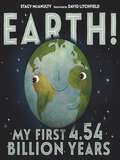
Earth! My first 4.54 billion years (Our Universe #1)
By Stacy McAnulty. 2021
Earth! My First 4.54 Billion Years is a lighthearted nonfiction audiobook about the formation and history of the world—told from…
the perspective of the Earth itself! "Hi, I'm Earth! But you can call me Planet Awesome ." Prepare to learn all about Earth from the point-of-view of Earth herself! In this funny yet informative book, filled to the brim with kid-friendly facts, listeners will discover key moments in Earth's life, from her childhood more than four billion years ago all the way up to present day. Beloved children's book author Stacy McAnulty helps Earth tell her story. The audiobook includes back matter with even more interesting tidbits. This title has Common Core connections. A Macmillan Audio production from Henry Holt and Company.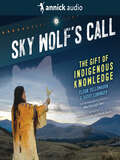
Sky wolf's call: The gift of indigenous knowledge
By Eldon Yellowhorn, Kathy Lowinger. 2022
From healing to astronomy to our connection to the natural world, the lessons from Indigenous knowledge inform our learning and…
practices today. How do knowledge systems get passed down over generations? Through the knowledge inherited from their Elders and ancestors, Indigenous Peoples throughout North America have observed, practiced, experimented, and interacted with plants, animals, the sky, and the waters over millennia. Knowledge keepers have shared their wisdom with younger people through oral history, stories, ceremonies, and records that took many forms. In Sky Wolf's Call , award-winning author team of Eldon Yellowhorn and Kathy Lowinger reveal how Indigenous knowledge comes from centuries of practices, experiences, and ideas gathered by people who have a long history with the natural world. Indigenous knowledge is explored through the use of fire and water, the acquisition of food, the study of astronomy, and healing practices. *A Junior Library Guild Gold Standard Selection
Sky Wolf's Call: The Gift of Indigenous Knowledge
By Eldon Yellowhorn, Kathy Lowinger. 2022
From healing to astronomy to our connection to the natural world, the lessons from Indigenous knowledge inform our learning and…
practices today. How do knowledge systems get passed down over generations? Through the knowledge inherited from their Elders and ancestors, Indigenous Peoples throughout North America have observed, practiced, experimented, and interacted with plants, animals, the sky, and the waters over millennia. Knowledge keepers have shared their wisdom with younger people through oral history, stories, ceremonies, and records that took many forms. In Sky Wolf’s Call, award-winning author team of Eldon Yellowhorn and Kathy Lowinger reveal how Indigenous knowledge comes from centuries of practices, experiences, and ideas gathered by people who have a long history with the natural world. Indigenous knowledge is explored through the use of fire and water, the acquisition of food, the study of astronomy, and healing practices. *A Junior Library Guild Gold Standard Selection
Counting the stars: The Story of Katherine Johnson, NASA Mathematician
By Lesa Cline-Ransome, Raúl Ón. 2019
Before John Glenn orbited the Earth or astronauts walked on the moon, a group of dedicated female mathematicians known as…
"human computers" used their knowledge, pencils, adding machines, and writing paper to calculate the orbital mechanics needed to launch spacecraft. Katherine Johnson was one of these mathematicians who used trajectories and complex equations to chart the space program. Even as Virginia's Jim Crow laws were in place in the early 1950s, Katherine worked analyzing data at the NACA (later NASA) Langley laboratory. For grades 2-4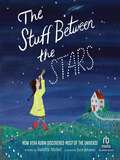
The stuff between the stars: How vera rubin discovered most of the universe
By Sandra Nickel. 2024
Before Vera Rubin discovered most of the universe, she was a girl who loved the night sky. She watched the…
Big Dipper circle the North Star. And when her eyelids grew heavy, she dreamed not about what she had seen, but about what she had not seen. She dreamed about the mysteries between the stars. As Vera grew older, she tried to uncover those mysteries. At her first conference, the male astronomers said her ideas were "outlandish." They said they were "ridiculous." Vera didn't like their harsh words, pushing her away. So she started studying faraway galaxies no one else was interested in. The youngest wheeled like pinwheels. The oldest spun with their arms closed tight. And every single one showed that between the stars, there is stuff we cannot see. Scientists before Vera had suspected this "dark matter" made up most of the universe. But no one had been able to show it was there. No one, until Vera. The Stuff Between the Stars tells Vera's incredible story, celebrates her brilliance, and shows how a girl's never-ending love for the night sky changed the way we see our universe today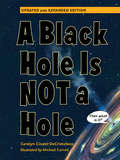
A Black Hole is Not a Hole: Updated Edition
By Carolyn Cinami DeCristofano. 2017
A black hole isn't really a hole . . . is it? Get ready to S-T-R-E-T-C-H your mind with this…
beloved and best-selling science book. Updated with an all-new chapter about the first black-hole image ever!What are black holes, what causes them, and how the heck did scientists discover them? Acclaimed STEM writer Carolyn DeCristofano's playful text shares how astronomers find black holes, introduces our nearest black-hole neighbors, and provides an excellent introduction to an extremely complex scientific topic. Gorgeous space paintings supplement real telescopic images, and funny doodles and speech bubbles keep the content light and fun.
Who Was Sally Ride? (Who was?)
By Megan Stine. 2013
In 1978, Sally Ride, a PhD candidate at Standford University, responded to a newspaper ad to join the US astronaut…
program. She was accepted and became the first American woman astronaut to fly in space! Among her other accomplishments, she played tennis like a professional, was an astrophysicist who helped develop a robotic arm for space shuttles, and later, through Sally Ride Science, worked to make science cool and accessible for girls. Sally Ride, who died on July 23, 2012, will continue to inspire young children.
Impact!: Asteroids and the Science of Saving the World
By Elizabeth Rusch, Karin Anderson. 2017
Asteroids bombard our atmosphere all the time. Some are harmless, burning up in a flash of light. But others explode…
with a great sonic boom, smashing windows and throwing people to the ground. Worst of all, some asteroids strike our planet, blasting out massive craters and destroying everything nearby on impact. Follow the award-winning author Elizabeth Rusch into the field with scientists as they search for dangerous asteroids in space, study asteroids that have smashed into the ground, and make plans to prevent an asteroid strike if one ever threatens our planet.
Shining Star: Vera Rubin Discovers Dark Matter
By Suzanne Slade. 2023
Pioneering astronomer Vera Rubin discovers dark matter—the mysterious substance that makes up most of the universe—while confronting sexism, and paves…
the way for future women scientists in this engaging STEM/STEAM picture book biography.From the moment she first looked out her window at the night sky, future astronomer Vera Rubin was star-struck. Her cosmic questions about stars, galaxies, and the universe gave Vera the drive to build her own telescope and earn multiple degrees in astronomy, despite an army of naysayers who thought women shouldn&’t reach for the stars.But Vera did reach for the stars. Studying spiral galaxies, she searched the skies all through the night, using telescopes in unheated observatories, some of which barred women until Vera insisted they let her in. And her studies revealed something stellar: evidence for the existence of dark matter, the most mysterious substance in the universe.Today, scientists continue to build off of Vera&’s groundbreaking work as they strive to better understand dark matter. A trailblazing scientist, Vera Rubin changed people&’s understanding of both the universe and what a woman can do.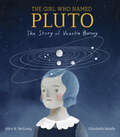
The Girl Who Named Pluto: The Story of Venetia Burney
By Alice B. McGinty. 2019
An empowering, inspiring--and accessible!--nonfiction picture book about the eleven-year-old girl who actually named the newly discovered Pluto in 1930.When Venetia…
Burney's grandfather reads aloud from the newspaper about a new discovery--a "ninth major planet" that has yet to be named--her eleven-year-old mind starts whirring. She is studying the planets in school and loves Roman mythology. "It might be called Pluto," she says, thinking of the dark underworld. Grandfather loves the idea and contacts his friend at London's Royal Astronomical Society, who writes to scientists at the Lowell Observatory in Massachusetts, where Pluto was discovered. After a vote, the scientists agree unanimously: Pluto is the perfect name for the dark, cold planet. Here is a picture book perfect for STEM units and for all children--particularly girls--who have ever dreamed of becoming a scientist.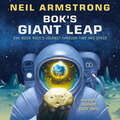
Bok's Giant Leap: One Moon Rock's Journey Through Time and Space
By Neil Armstrong. 2021
First man on the moon Neil Armstrong's only children's book is a unique exploration of how the Earth and the…
Moon came to be.The entire epic history of the Earth and the Moon is recounted through the observations of one special moon rock named Bok. Geologists say that rocks remember, and Bok certainly does. It recounts how its life began on Earth, until a collision with an asteroid catapults it into orbit during the creation of the Moon. From the Moon's surface, Bok watches the developing planet change from afar--until a strange creature scoops him up and brings him back to Earth. When NASA honored Apollo 11 astronaut Neil Armstrong and gave him a piece of moon rock from that mission, Armstrong playfully named the rock Bok in his acceptance speech. Award-winning illustrator Grahame Baker-Smith has created a breathtaking, one-of-a-kind picture book based on that speech, combining fascinating science and history with the grandest human adventure of all.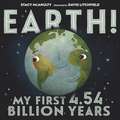
Earth! My First 4.54 Billion Years (Our Universe #1)
By Stacy McAnulty. 2017
A lighthearted nonfiction picture book about the formation and history of the Earth--told from the perspective of the Earth itself!"Hi,…
I’m Earth! But you can call me Planet Awesome." Prepare to learn all about Earth from the point-of-view of Earth herself! In this funny yet informative book, filled to the brim with kid-friendly facts, readers will discover key moments in Earth’s life, from her childhood more than four billion years ago all the way up to present day. Beloved children's book author Stacy McAnulty helps Earth tell her story, and award-winning illustrator David Litchfield brings the words to life. The book includes back matter with even more interesting tidbits.This title has Common Core connections.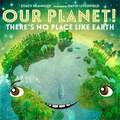
Our Planet! There's No Place Like Earth (Our Universe #6)
By Stacy McAnulty. 2022
From writer Stacy McAnulty and illustrator David Litchfield, Our Planet! There's No Place Like Earth is a nonfiction picture book…
about the Earth, told from the perspective of Earth herself.Meet Earth. Planet Awesome! And your awesome home! Actually, Earth is home to all the plants and all the animals in the solar system, including nearly eight billion people. Humans have accidentally moved Earth's climate change into the fast lane, and she need your help to put on the brakes. Earthlings need Earth, and Earth needs Earthlings, so let’s save Earth together!With characteristic humor and charm, Stacy McAnulty channels the voice of Earth in this next celestial "autobiography" in the Our Universe series. Rich with kid-friendly facts and beautifully brought to life by David Litchfield, this is an equally charming and irresistible picture book.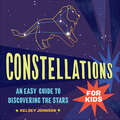
Constellations for Kids: An Easy Guide to Discovering the Stars
By Kelsey Johnson. 2020
The perfect gift for any curious, space-loving kid! Explore the constellations with this guide to navigating the sky for ages…
6 to 9Over thousands of years, stargazers have noticed shapes in the stars, also called constellations. Different cultures have seen mythical animals and heroes within these constellations, and many travelers have used the stars as a guide for their journeys. Constellations for Kids—by astronomy professor Kelsey Johnson—shows you how to read the night sky and discover more than 25 unique constellations as you learn about outer space and the solar world.From Canis Major to Cassiopeia, each constellation in this astronomy book for kids includes easy-to-read sky maps and step-by-step instructions for identifying it in the night sky. You'll also learn how to use bright stars as guides to show you where to find each constellation!This constellations book for kids includes:Beginner-friendly content—Build up your knowledge of astronomy with simple explanations of key concepts that help you understand stargazing.Simple line illustrations—Each constellation includes an illustration of what it looks like in the sky, making it easier for you to find them.Fun facts mythology—Learn about all kinds of cool celestial facts and ancient mythology. Did you know Lyra is the only Greek constellation that is a musical instrument?Explore the stories written in the stars with this fun guide to stargazing for kids!